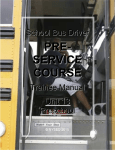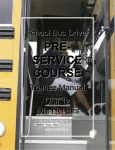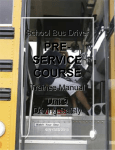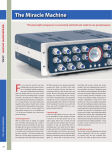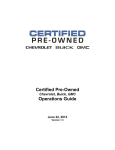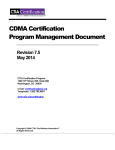Download Pre-Service Course Trainee Manual
Transcript
School Bus Driver PRESERVICE COURSE Trainee Manual Unit 11 Inspections © ©N NY YS SE ED D 22001100 State School Bus Driver Pre-Service Manual Unit 10 p. 1 This page intentionally left blank. State School Bus Driver Pre-Service Manual Unit 11 p. 2 Acknowledgements We could not have prepared this curriculum without the ideas, enthusiasm, and guidance of the following people: Marion Edick, State Director of Pupil Transportation NYSED SBDI Advisory Committee: Jim Brown, Robert Brown, Jason Burrick, Jorge DeJesus, Lorraine Misciagno, Susan Soudant, Faye Stevens, Peter Brockmann, Betty Hughes, Patricia Martell, Paul Mori, Chuck Paquette, Joseph Van Aken, Patricia Bailey, Lenny Bernstein (chair), Ted Finlayson-Schueler, Kathy Furneaux, Peter Lawrence, Peter Montalvo, James Rogan, and Maureen Ryan Safety Rules! Curriculum Advisory Committee: Lance Frieberger, Cliff Berchtold, Joe Van Aken, Paul Mori, Mike Dello Ioio, Faye Waxman, Robin Parks, Teena Fitzroy, Deanna Adams, Peter Lawrence, Deb Stevens, Greg Jenne, and Judy Clarke Moravia CSD School Bus Drivers, Attendants, and Mechanics Attendees at Syracuse focus group: Tyronne Worrell, Luther Everson, Cindy Raulli, Deb Lilley, Deb Stevens, Tammy Payne, Chuck Paquette, Barb Biddlecome, Terri Kuss, Shelly O’Riley, and Pat Bailey Attendees at Rochester focus group: Peter Lawrence, Michael Proukou, and Kitty Rhow Lee Comeau, retired, author of the original (1989) Pre-Service Course - JE & TFS, June, 2010 Title: School Bus Driver Pre-Service Course – Trainee Manual Unit 11 Authors: Jim Ellis and Ted Finlayson-Schueler Copyright June 30, 2010 The University of the State of New York The New York State Education Department Office of Pupil Transportation Unit EBA, Room 876 Albany, NY 12234-0001 Phone: (518) 474-6541 • Fax: (518) 474-1983 State School Bus Driver Pre-Service Manual Unit 11 p. 3 INTRODUCTION Welcome, new New York State school bus driver! The School Bus Driver Pre-Service Course has one goal: to prepare you to safely transport children on a school bus. You are entering a proud profession. New York State’s school bus drivers have established an admirable safety record over the past generation. Statistically, New York’s school buses represent the safest form of ground transportation ever devised. Children riding in school buses are approximately 24 times safer than when they’re riding in the family car! However, student safety is never assured. Your responsibility for safety will be serious from the first day you drive a bus with children on board. What you learn in this course can save a child’s life. This Trainee Manual will prepare you for the course. Read it carefully before the course begins. Complete the review questions at the end of each Unit before you come to class. Write down any questions you have for your instructor. If you don’t understand something, say so. Asking questions is one sign of a professional. Again, welcome to our New York State school bus safety community! Marion Edick New York State Education Department State Director of Pupil Transportation State School Bus Driver Pre-Service Manual Unit 11 p. 4 OPTIONAL UNIT 11: SCHOOL BUS PRE-TRIP AND POST-TRIP INSPECTIONS Unit 11 Topics 11.1 Professional School Bus Driver’s Pre-Trip Inspection 11.2 Daily Vehicle Reports 11.3 Post-Trip Inspection 11.4 Unit 10 Review Introduction Commercial vehicle safety inspections are required by state and federal law, but school bus pre-trip inspection is more than a law. A careful check of all safety features on your bus is the sign of a truly professional school bus driver. Children’s safety depends on a quality pre-trip inspection. Obtaining the CDL is only the starting point of becoming a professional school bus driver. Because of budget constraints and safety considerations, the CDL road test does not include a full pre-trip inspection. The superficial pre-trip required during DMV’s road test is insufficient once you begin to actually transport students. 11.1 Professional School Bus Driver’s Pre-Trip Inspection 11.1.1 Why pre-trips are important. Compliance with state and federal laws is important, but the most important reason for doing a quality pre-trip inspection of your bus is student safety. School buses are safe vehicles. They are well built and well-maintained. School bus mechanics and technicians take their demanding jobs seriously, and across the state have established an impressive safety record. The New York State Department of Transportation inspects every school bus twice a year. Its inspection standards are the strictest in the nation. The slightest mechanical problem discovered during a DOT inspection could decertify that bus. Unlike a generation ago, few school bus accidents today are caused by mechanical failures. However, mechanical problems still occur. School buses are complicated machines and machines break down. School bus technicians take their demanding jobs seriously, but mechanical problems still occur – school buses are complicated machines and machines break down. Even in a small school bus operation, a log of mechanical failures over the course of a school year will typically include items such as leaking radiator hoses, air line leaks, oil leaks, fuel leaks, flat tires, broken belts and alternator failures, failed back up alarms, loose New York State School Bus Driver Pre-Service Manual Unit 11 p. 5 seat cushion latches, cut seats, defective emergency window and door buzzers, broken roof hatches, loose stepwell treads, missing exit labels, jammed seat belts, exhaust leaks, cracked springs, electrical shorts, heater motor failures, stop arm failures, brake chamber failures, cracked lenses, and many blown bulbs. As time passes and you settle into your new career of driving a school bus, remain alert as These typical mechanical failures share two extremely important characteristics: 1. Unrepaired mechanical failures or defects can cause injury to a child or cause a crash. 2. Each mechanical problem listed above should be discovered by an alert driver during a pre-trip inspection. (Similarly, a cursory pre-trip – walking around the bus halfasleep, halfheartedly kicking at a tire – could easily miss every mechanical problem listed above.) School bus pre-trip inspections are too important to just “go through the motions.” A superficial inspection could send an unsafe bus on the road. Learn how to conduct a professional pretrip. Although at first it will seem like a lot of items to check, it will become second nature when you do it every day. Never let yourself become complacent about vehicle safety. It takes ten to fifteen minutes to conduct a thorough vehicle inspection. The more you do it, the more efficient you will become at it. Conduct a meticulous safety inspection of every school vehicle you drive every day. New York State School Bus Driver Pre-Service Manual Unit 11 p. 6 you check out the bus. Never let yourself become complacent about vehicle safety. 11.1.2 Pre-trip safety. Be careful when conducting a pre-trip inspection: • Wear shoes with good tread to prevent slips and falls. Avoid loose clothing and long drawstrings or necklaces that could become tangled in vehicle components as you check them out. • Be aware of what the buses parked next to yours are doing as you proceed with your pre-trip. If they’re pulling out of their parking spaces, stand back. • Some stop arms have sharp edges. Don’t bump your head on a deployed stop arm. • Make sure you have good footing as you check your emergency doors from inside the bus. Drivers have lost their balance and fallen out the exit. • Closing emergency windows can be tricky. You can pinch your fingers if you’re not careful. • Be careful if you are required to check under the hood. (Some operations require it, and some don’t.) Lift and close the hood gently – take care that it doesn’t “get away from you” and slam down. You could be hurt, or the hood could be damaged. Bus drivers should not check under the hood while the engine is running – that’s a job for the mechanics. • If you’re checking out a vehicle that’s recently been used by another driver, don’t burn yourself on hot engine or exhaust components. • Take care not to trip on engine block heater plug-in cords during cold weather. Unplug your bus before starting it. Be sure it’s unplugged before leaving your parking space! 11.1.3 Model pre-trip. Learn your school district’s or bus company’s specific inspection policies and procedures. Some operations require additional items to be checked, some do not require or allow drivers to check under the hood, and some prefer a different sequence than the one presented below. A model pre-trip consists of nine basic steps – following this sequence minimizes the number of times you must walk around your bus. A model pre-trip consists of nine basic steps. Following this sequence minimizes the number of times you must walk around your bus. 1. Approach the bus. 2. Check under the hood (if required by local policy). 3. Enter the vehicle, check controls, start engine, set lights. 4. Exit vehicle, full walk-around. 5. Re-enter vehicle, check New York State School Bus Driver Pre-Service Manual Unit 11 p. 7 emergency equipment, re-set lights. leaf springs intact, no cracks 6. Exit vehicle, curbside light check. 2g) Front slack adjusters present, pins intact 7. Re-enter vehicle, static brake check. 8. Check interior items. 9. 50’ brake checks. STEP 1: Approach the bus. In the early morning, use a flashlight, or if you park in front of your bus, leave your car headlights on to help see underneath the bus. As you approach your bus, check for: 1a) Damage to body, broken windows, vehicle leaning to one side, anything unusual 1b) Fluids underneath the vehicle (puddles from “static” leaks – oil, coolant, grease, fuel) 1c) Hanging items (wires, exhaust, drive shaft) 1d) Anything unusual beneath or around the bus (tools, parts, overhanging branches, packages, etc.) 1e) Unplug the bus (winter) STEP 2: Check under the hood (if required by local policy). 2a) Belts secure, not frayed; no leaks or cuts or signs of rubbing or wear on hoses; check carefully around hose clamps where leaks often start 2b) Oil level 2c) Coolant level 2d) Windshield washer fluid level 2e) Air lines intact, no cracks or cuts, no signs of tire rubbing against air line 2h) Drag link secure 2i) Steering column secure, steering fluid line not rubbing against steering column 2j) Battery box, nothing unusual inside compartment, batteries not tipped over - check battery box before starting engine STEP 3: Enter vehicle, check controls, start engine, set lights. 3a) Make sure the parking brake is set – turn the key to accessory, but don’t start the engine 3b) Check the function of all switches and controls (top to bottom, left to right, high and low settings) – listen for fans and heater motors 3c) Start the engine – listen for knocking or other unusual noises; do not race the engine, but in cold weather set it at higher idle (1200 rpm) 3d) Check the oil pressure gauge first to make sure there’s oil pressure and to prevent damage to the engine; then check all other gauges (top-bottom, left-right); make sure the alternator is charging (with some models, you may have to rev the engine slightly to kick it in) 3e) Check the steering wheel; turn it several inches both directions – there should be no freeplay, binding, or catching 2f) Front shock absorbers intact, no leaks; New York State School Bus Driver Pre-Service Manual Unit 11 p. 8 Check each wheel and tire carefully, starting from the outside in toward the center. 4f) Left turn signals (including side signals) 3f) Set lights for your walk-around – turn on headlight low beams, marker/clip lights, sign light, master flasher switch, and left turn signal. STEP 4: Exit vehicle, full walkaround. 4a) Start at front right wheel and walk counterclockwise around vehicle 4b) Wheels and tires – check each wheel and tire starting from the outside and working in toward the center: inflation; adequate tread (at least 1/8” front tire) all the way across road contact surface of tire; no cracks or cuts in the side wall; no nails or other items in tire; valve stem present and centered between spacers; no dents or cracks in rim or wheel; lug nuts tight and no rust or bare metal visible; no grease visible from grease seals; no stones or other objects lodged between rear duals 4c) Marker or clip lights – corners, front and rear, sides of roof 4d) Headlights – low beams 4e) Running lights and taillights 4g) Mirror brackets secure, mirrors clean (use rag as necessary) 4h) Hood latched – both sides 4i) Red student flashers 4j) Antenna(s) 4k) Sign lights (may not be visible in bright sunlight – if not visible, check from inside) 4l) Stop signs and flashers 4m) All reflectors and reflective tape 4n) “Pressure” leaks underneath front and sides of bus – coolant, fuel, oil 4o) Emergency doors, buzzers, seals, safety catch – open emergency doors all the way, being careful to not break the safety catch (note: check emergency reflector triangles from outside rear door if they’re located at the rear of the vehicle) 4p) Damage to body, windows, roof – report any new scratches or dents 4q) Underneath the bus – hanging or loose wires, drive shaft and drive shaft protectors, rear springs intact, etc) 4r) Exhaust system secure – push end of pipe with foot (not your hand New York State School Bus Driver Pre-Service Manual Unit 11 p. 9 – it could be hot) : end of exhaust pipe should extend beyond rear bumper 4s) Fuel cap tight STEP 5: Re-enter vehicle, check emergency equipment, re-set lights. 5a) Step well light, steps clear, handrail secure 5b) Fire extinguisher – fully charged, pin present, secure in bracket 5c) Seat belt cutter(s) if present 5d. First aid kit – stocked (check kit on assigned bus at least once a week; check daily on a spare bus), kit secure in bracket, labeled Check inside the emergency reflector box at least weekly on your regularly assigned bus; check every day on spare buses. 5e) Body spill cleanup kit – stocked (check kit on assigned bus at least once a week; check daily on a spare bus), secure in bracket, labeled 5f) Vehicle registration, DOT inspection sticker, and insurance cards present 5g) Emergency reflector triangles present (if located at front of vehicle) – check inside the box at least weekly on your regularly assigned bus, daily on a spare bus – make sure reflectors haven’t come apart 5h) Re-set lights – activate high beams and right turn signal STEP 6: Exit vehicle again, check curbside lights. 6a) Proceed to front and then back along right side of vehicle again 6b) High beams 6c) Right turn signal – front, side, rear STEP 7: Re-enter vehicle, static brake check. 7 a) Close passenger door and take seat 7b) Turn engine off and leave key in accessory position; place bus in reverse, go to back of bus, and check back-up lights and beeper from inside (unless you have a buddy to check for you from outside) 7c) Leave the key in the accessory position; release parking brake (place a standard transmission bus in gear to prevent it from rolling; with an automatic transmission bus, rest your foot over the foot brake in case it starts rolling) 7d) Air brake-equipped bus: before starting a static air brake check make sure the air is fully charged, the wigwag is set, and the key is in the accessory position; first, check for air leaks in the spring brake system – with the spring brake pushed in and before applying the foot brake, watch the air gauge needles and listen for leaks; if there are no leaks, hold down the foot brake pedal hard to check the foot brake lines – watch the needles and listen for leaks; if there are no leaks, pump the foot brake repeatedly until all three emergency warning devices activate (wigwag, buzzer, light – they New York State School Bus Driver Pre-Service Manual Unit 11 p. 10 should come on at approximately 60 psi); continue pumping until the spring brake comes on (it should come on at approximately 25 psi); then, re-start the engine and check air pressure buildup – air gauge needles should build simultaneously at approximately 15 psi every 45 sec); remember to reset the wigwag after the system is recharged with air 7e) Hydraulic brake-equipped bus: with key off, depress foot brake pedal, listen for whirring sound of brake booster motor if so equipped; with key on but engine off, check brake warning light/buzzer; pump brake pedal three times - pedal should stay firm. STEP 8: Check interior of bus. 8a) With the engine running and the passenger door closed, activate 4-way flashers and amber student flashers cushion at the seat “bight” where seat back and cushion meet – cushions often come loose); check seat belts – all should be accessible; check “jump seat” operation next to side emergency door – jump seat should spring back to full upright position 8f) Return to driver’s seat – adjust it as necessary before leaving yard; fasten and properly adjust driver seat belt 8g) Ask a buddy (another driver or attendant) to check your brake lights (in low light conditions you may be able to use your driving mirror to see brake lights flashed on and off in a reflective surface behind your bus, such as the windows on other parked buses; some operations mount exterior mirrors across the lot to help drivers check their brake lights) Check mirror adjustment carefully before leaving the yard. 8b) From the driver’s seat, check front 4way flashers and amber student flashers using pedestrian crossover mirrors or by leaning against windshield 8h. Check mirror adjustment carefully (driving mirrors and pedestrian crossover mirrors) before leaving the yard 8c) Leave your seat and walk the aisle to the back of the bus, checking interior items along the way – seat backs: (look for cuts or other vandalism ); all emergency exits (doors, windows, and roof hatches) must be opened, not just pushed up into the “vent” position; exit labels and decals, and red lights over emergency doors 8i. Check horn 8d) Open the rear door and lean out far enough to check amber flashers and 4way flashers 8e) Return to the front of the vehicle, checking seat cushions (pull up on each STEP 9: 50’ brake checks (whenever possible, at a safe distance from other parked buses). 9a) Check the parking brake – it should hold your bus with the transmission in “Drive” and the engine at high idle 9b) Perform a 50’ service brake check with the bus moving forward at approximately five mph – the bus should stop smoothly and quietly without pulling hard to either side New York State School Bus Driver Pre-Service Manual Unit 11 p. 11 Note: Wheelchair lifts, wheelchair tiedown systems, seat belt cutter, and the fire blanket must also be checked if the vehicle is lift- equipped. Check the full operation of the wheelchair lift before leaving the yard. (See Optional Unit 11 for more about checking wheelchair lifts and other special needs equipment.) A pre-trip inspection of vans has several unique features. 11.2 Driver’s Daily Vehicle Reports 11.2.1 Legal requirement. New York State Department of Transportation requires the driver of every school bus to file a written report of its mechanical condition at the end of the day. Driver’s Daily Vehicle Reports (DDVR) should be taken with utmost seriousness by drivers. Your signature is required twice – first, after conducting your pre-trip inspection, certifying that the bus was in safe condition when it left the yard. Second, after your post-trip inspection at the conclusion of the run, certifying that the bus was still in safe working order at the end of the day. Any mechanical problems discovered during your pre-trip inspection, while driving, or at the end of the day must be described. Treat DDVRs seriously – should an accident occur, the DDVR you signed will be reviewed for any indication that the bus was not in sound mechanical condition at the start of the run. DDVRs must be filled out completely and legibly. Mileage numbers must be accurately transcribed – any gaps in the mileage of successive DDVRs will be questioned by NYS DOT at the next bus inspection. Should an accident occur, the DDVR you signed will be scrupulously reviewed for any indication that the bus was not in sound mechanical condition at the start of the run. It is very important that you sign the DDVR before leaving the bus yard for your first run. Your signature protects you from a subsequent charge that you didn’t inspect the bus as required by law. If mechanics repair, service, or work on a vehicle for any reason they must indicate what was done and sign off on the DDVR. The next time that bus is used, the bus driver using it must counter-sign under the mechanic’s signature. This legal signature chain is intended to prevent unsafe buses from transporting children. DDVRs are legal documents and must be retained by the operation for at least a year. 11.2.2 Mechanics need to know now. Don’t wait until you turn in the DDVR at the end of the day to inform mechanics of a mechanical problem. Tell them at once. If it’s a minor problem, such as a blown clip light, it can usually be repaired on the spot. If the problem is more serious, you shouldn’t use the bus. New York State School Bus Driver Pre-Service Manual Unit 11 p. 12 Mechanics work hard. Ask your supervisor or your Head Mechanic what’s the best way to communicate with busy mechanics in the morning. 11.3 Post-Trip Inspection 11.3.1 Your most important responsibility. You must check for children before getting off your bus for any reason. It’s a law. This means getting out of your seat and walking the aisle to the back of the bus, carefully checking both on and under seats. Many, many children fall asleep on their buses. Others try to hide under the seats for whatever childish reason. At a minimum, leaving a child on the bus will result in serious disciplinary action against the bus driver. Often, it will mean the end of his or her career as a bus driver, or even a criminal charge of endangering the welfare of a child. Losing your job or being arrested, however, is not the worst thing that could happen. The worst case scenario is a panicked child being left on a bus in the bus yard for hours in freezing or sweltering weather. Children have died when left in vehicles by distracted adults. State law requires both attendants and bus drivers to check for sleeping children. Don’t assume the attendant checked. You check, too – every time you park your bus. 11.3.2 Other responsibilities at the close of the day. Never be in a hurry at the end of your bus driving day. There are still important duties to fulfill after you’ve dropped off the last students and parked your bus. Be a professional from the start to the finish of your day. • Always leave your bus ready for its next use. Never leave a bus with less than half a tank of fuel. What if there’s a sudden school or community emergency? • Before shutting off a diesel bus, let it cool down at low idle for 3-5 minutes. This prevents damage to the engine. • While your engine is cooling down, do a walk-around, checking lights and looking for any damage or mechanical problem. Report any minor problems such as a light out at once, so mechanics have time to fix it before the next day. State law requires both attendants and bus drivers to check for sleeping children. Don’t assume the attendant checked - you check, too. • When you shut off the engine, turn off all switches and controls. This prevents excessive draw on the batteries the next morning. • Sweep your bus every day; empty trash as necessary, but at least weekly. A dirty bus is unhygienic and unprofessional. Make sure seat belts are accessible. Seat belts should not be left dangling on the floor to get filthy or to trip students. New York State School Bus Driver Pre-Service Manual Unit 11 p. 13 • With an air brake-equipped bus, always pump down your brakes before you get off the bus at the end of the day (or for any other reason). This is a requirement of the New York State Education Department. Pump them all the way down to approximately 15 psi. This ensures no one can release the spring brake, letting the bus roll. • Close all windows (including driver window) and hatches. Double-check – open windows and hatches let in rain (which can damage vehicle components) as well as birds, bats, bees, and other critters. Make sure your door is fully closed as you exit the bus. • Complete your Driver’s Daily Vehicle Report carefully and accurately. Bring it and the bus key into the office according to local procedure. New York State School Bus Driver Pre-Service Manual Unit 11 p. 14 11.4 Unit 11 Review Write down or circle the best answer(s). 1. TRUE or FALSE? “The pre-trip inspection required during a CDL road test is adequate once you begin transporting students.” 2. TRUE or FALSE? “School bus technicians take their demanding jobs seriously, but mechanical problems still occur. School buses are complicated machines and machines break down.” 6. List three things you should be looking for when you approach your bus at the start of the pre-trip: 1. 2. 3. 7. Which gauge should you check first when you start the engine? a. Coolant temperature gauge. b. Fuel gauge. c. Oil pressure gauge. 3. List three things you can do to prevent an injury when conducting a pre-trip inspection: 1. d. Air pressure gauge. 8. List 10 items you should check during the full walk-around during your pre-trip: 2. 1. 3. 2. 4. List the 9 basic steps of a model pre-trip inspection: 3. 4. 1. 5. 2. 6. 3. 7. 4. 8. 5. 9. 6. 10. 7. 9. List three types of emergency equipment you should check during your pre-trip: 8. 1. 9. 5. Which pre-trip step depends on local policy? 2. 3. New York State School Bus Driver Pre-Service Manual Unit 11 p. 15 10. List three things that must happen before you can conduct a static air brake check: 16. What are the possible consequences for failing to check for children at the end of a run ? 1. a. Disciplinary action or firing of bus driver. 2. b. Criminal charge of endangering the welfare of a child. 3. 11. List five things you should check in the interior of your bus: 1. c. Child could be hurt or killed. d. All of the above. 17. After checking for children, what are three other duties at the end of the day? 2. 1. 3. 2. 4. 3. 5. 12. TRUE or FALSE? “The 50’ brake check should be conducted at 20 mph.” UNIT 11 NOTES & QUESTIONS 13. TRUE or FALSE? “The 50’ brake check should be conducted at a safe distance from other parked buses whenever possible.” 14. How many times must you sign a Driver’s Daily Vehicle Report each day? 15. When must mechanics sign the Driver’s Daily Vehicle Report? a. When they’ve repaired, serviced, or worked on a bus. b. Every time the bus is used. c. Mechanics are never required to sign the DDVR. d. None of the above. New York State School Bus Driver Pre-Service Manual Unit 11 p. 16
















